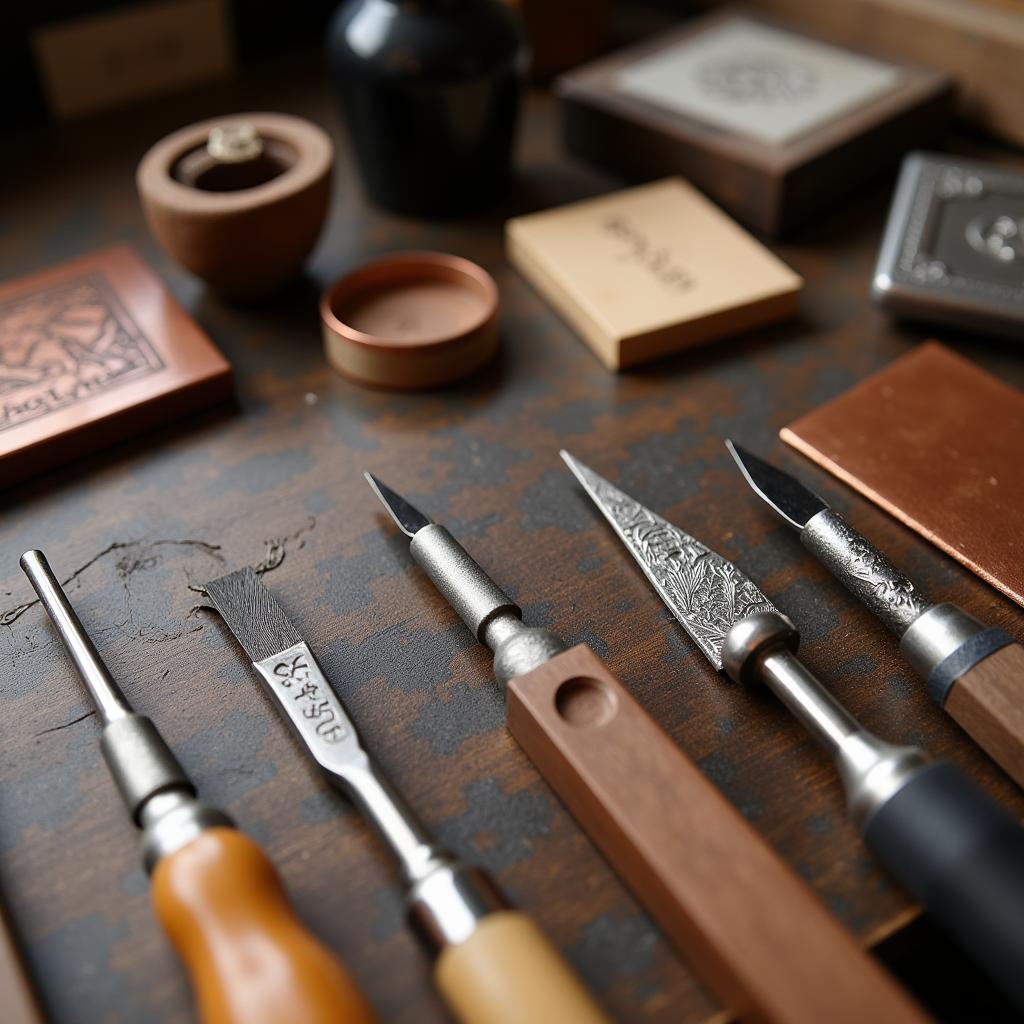The Art of Engraving: A Journey Through Time and Technique
The Art Of Engraving, a timeless craft that marries artistry with meticulous technique, has captivated civilizations for centuries. From ancient cave paintings to modern-day printmaking, the allure of engraving lies in its ability to transform simple surfaces into intricate masterpieces.
Delving into the Depths of Engraving: What Exactly is It?
Engraving, in its purest form, involves the precise incision of designs onto a hard surface. This surface, often metal, wood, or glass, becomes a canvas for the engraver’s vision. Using specialized tools like burins, chisels, or lasers, the artist meticulously carves away material, leaving behind a network of grooves that form the desired image or pattern.
 An Assortment of Engraving Tools and Materials
An Assortment of Engraving Tools and Materials
A Historical Tapestry: Tracing the Evolution of Engraving
The roots of engraving run deep, weaving through history and leaving their mark on various cultures. Early examples of engraving date back to prehistoric times, evident in the intricate carvings found on bone and stone artifacts. Ancient civilizations, including the Egyptians and Mesopotamians, embraced engraving as a means of storytelling, adorning jewelry, weapons, and even tomb walls with detailed engravings.
The invention of the printing press in the 15th century marked a pivotal moment for engraving. Suddenly, the ability to reproduce engraved images on a larger scale revolutionized communication and artistic expression. This era witnessed the rise of renowned engravers like Albrecht Dürer, whose masterful woodcuts and engravings redefined the artistic landscape.
Mastering the Craft: Exploring Engraving Techniques
Over the centuries, engraving has branched out into a diverse array of techniques, each with its unique characteristics and applications:
-
Wood Engraving: Utilizing woodblocks as the primary medium, this technique involves carving away the wood surface to create a relief image. Known for its bold lines and graphic quality, wood engraving was widely used for book illustrations and prints.
-
Copperplate Engraving: This technique, favored for its intricate detail and delicate lines, involves incising designs onto copper plates. The engraved lines hold ink, which is then transferred to paper under pressure, resulting in a reversed image.
-
Etching: A chemical process, etching involves coating a metal plate with an acid-resistant ground. The artist then draws into the ground, exposing the metal beneath. Submerging the plate in acid etches the exposed areas, creating recessed lines that hold ink.
-
Laser Engraving: A modern take on a traditional craft, laser engraving utilizes focused laser beams to vaporize material and create precise engravings on various surfaces, including metal, glass, wood, and even leather.
 Ancient Egyptian Engravings Adorning a Tomb Wall
Ancient Egyptian Engravings Adorning a Tomb Wall
The Enduring Allure of Engraving in the Digital Age
While technology has ushered in new forms of digital art, the art of engraving continues to thrive, captivating artists and art enthusiasts alike.
“The beauty of engraving lies in its tangible connection to the creative process,” says renowned engraver and printmaker, Dr. Emily Carter. “The physical act of carving, of shaping the material with your own hands, creates a profound sense of intimacy with the artwork.”
Indeed, the tactile nature of engraving, the interplay of light and shadow on the engraved surface, and the enduring quality of the finished pieces imbue this art form with a timeless appeal.
Conclusion: The Art of Engraving – A Legacy of Precision and Artistry
From its humble beginnings to its modern-day interpretations, the art of engraving continues to inspire and captivate. Whether appreciating the intricate details of a 16th-century copperplate engraving or marveling at the precision of laser-engraved designs, the legacy of this ancient craft lives on, reminding us of the enduring power of human creativity and the timeless beauty found in meticulous detail.
FAQs about the Art of Engraving
1. What are the best materials for beginners to start engraving on?
For beginners, softer materials like linoleum blocks or wax plates offer a more forgiving surface to practice engraving techniques. These materials allow for easier carving and provide a good introduction to the fundamentals of engraving.
2. What are the essential tools needed for engraving?
Essential engraving tools include a variety of burins with different shapes and sizes for creating various line weights and textures. A sharpening system for maintaining the sharpness of the burins is crucial. Other necessary tools include a bench vise to secure the engraving plate and a loupe for magnified viewing.
3. How do I transfer my design onto the engraving surface?
Several methods exist for transferring designs onto the engraving surface. One common technique is to coat the surface with a thin layer of transfer paper and then trace over the design, which transfers the image onto the surface. Alternatively, some artists use projectors to project their design onto the surface for tracing.
4. How long does it take to create an engraving?
The time required to create an engraving varies greatly depending on the complexity of the design, the size of the engraving, and the skill level of the artist. Simple engravings can be completed in a few hours, while more intricate and larger pieces can take days, weeks, or even months to complete.
5. Where can I learn more about the art of engraving?
Numerous resources are available for those interested in learning more about engraving. Local art centers and community colleges often offer engraving classes and workshops. Online platforms provide tutorials, demonstrations, and access to online communities of engravers. Additionally, museums and art galleries often host exhibitions featuring historical and contemporary engravings, offering insights into the diverse world of this art form.
Need Assistance? We’re Here to Help!
If you’re eager to embark on your engraving journey or seeking further guidance, our team at dark aquarius art is here to assist you. We offer a range of resources, including workshops, tutorials, and personalized guidance, to help you delve into the captivating world of engraving.
Contact our dedicated team at:
Phone: 02462573573
Email: [email protected]
Visit us at: Savico Megamall, 7-9 Đ. Nguyễn Văn Linh, Gia Thụy, Long Biên, Hà Nội 10000, Việt Nam. Our customer support team is available 24/7 to answer your queries and provide the assistance you need.


